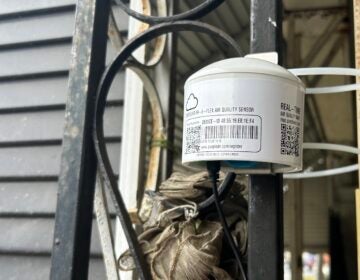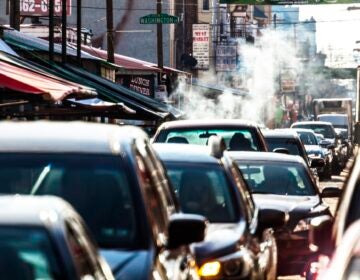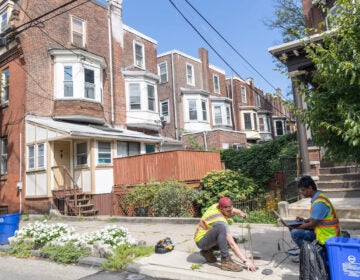Tackling the heat island problem in concrete jungles
Listen 8:02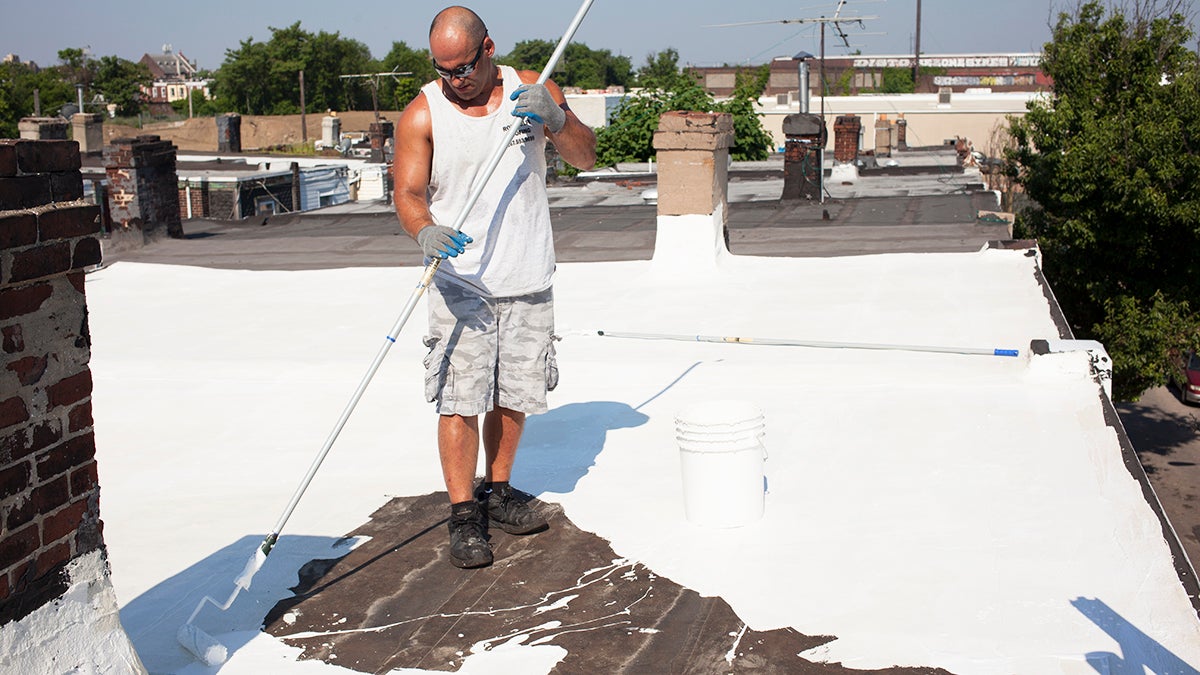
Roofer Rob Nolfi applies a reflective topping on a rehabbed roof in North Philadelphia. Cool roofs help keep temperatures down when the city heats up. (Irina Zhorov/The Pulse)
Health issues and energy costs soar when the temperatures rise.
It’s a hot day in June when I visit Ledean Durant’s North Philadelphia rowhouse. Her home has a newly insulated roof and other renovations that make it comfortable today, but stifling hot air used to get trapped on the second floor, where her bedroom is. That’s also where Durant’s Blue Crown Conure, Birdie, lives.
Birdie is a tropical parakeet but the heat was too much.
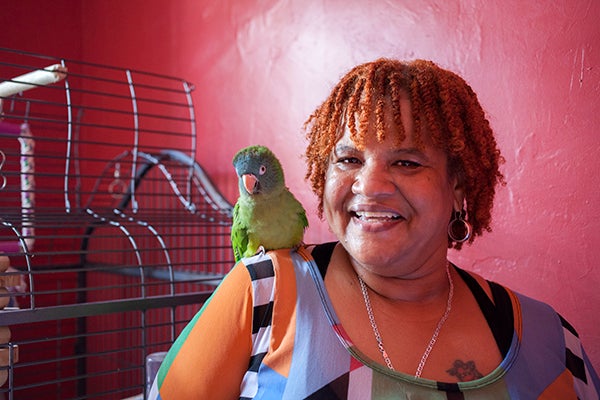
Durant would spritz the bird with water but she would “be kind of gasping for air … you could just see her panting, with the little tongue out,” Durant said.
Durant has asthma and has a hard time breathing, too.
“If it’s like 95 outside, it would feel like maybe 100 degrees” inside, she said.
Overheated homes like Durant’s are a common problem in Philadelphia. Homes were often not built to handle high heat. At the same time, as the city grew and people replaced dirt and trees with paved roads and buildings, they turned the city into a heat trapping island. Heat leads to more energy for cooling, more air pollution, and more public health issues, such as respiratory problems and heatstroke. But Philadelphia is slowly working on solutions.
Where heat thrives
To see where heat concentrates in the city, I sat down with Ken Steif, a city-planning professor at the University of Pennsylvania and data scientist with the firm Urban Spatial.
Steif used satellite data from a July day in 2016, when temperatures were in the 90s, to map the surface temperatures around the city. He found heat pockets.
“We can see that there are certain areas, certain hotspots, that are hotter than others,” he said zooming in and out of the map to highlight different neighborhoods.
He zoomed in on black roofed warehouses in North Philadelphia. Black absorbs heat and can turn a building into a kind of solar oven. On the map, the warehouses glowed bright red, indicating surface temperatures around 115 degrees Fahrenheit. The vast parking lots that surround the sports stadiums in South Philadelphia also blushed red. Temperatures in the low 100s spread out across the dense downtown like an orange bruise on the map.
“Conversely if you look in my neighborhood in West Philly around the Woodland Cemetery and in Clark Park you can see it’s much cooler,” Steif said, moving the map.
West Philadelphia is less dense and has many trees. A large park in the western part of the city and the rivers also appeared as a cool green on the map, around 75 degrees.
“Living vegetation, it’s sort of like an air conditioning system, it brings water up out of the ground and then it evaporates it into the tree canopy, and so that has a sort of natural cooling effect,” said Marc Imhoff, a scientist with NASA’s Goddard Space Flight Center and the University of Maryland.
Heat Island
If you zoom out across the region, the city, as a whole, burns hotter on the map than the suburbs and surrounding rural areas. Meteorologists and city planners call this the heat island effect.
“It was first perceived in London, during the Industrial Revolution when London was growing very rapidly, people realized that it seemed to be much warmer in the city than it was in the outlying areas,” Imhoff said.
This is true in Philadelphia, too.
This city was carved long ago into what used to be forest. Today, blocks and blocks of row houses face off along asphalt streets and cement sidewalks. It’s an old city, where houses are not well-insulated, and many people can’t afford to pay for air conditioning. Parts of Philadelphia are notably treeless. Ken Steif, the city planning professor, said in South Philadelphia, a neighborhood settled by Italians, people liked to be able to see the bustle on the street and check on their neighbors out their windows, so trees didn’t fit the culture.
On average, urban air temperatures in cities are two to five degrees higher than surrounding suburban and rural areas. That difference in temperatures can be significantly higher at night, as impermeable surfaces in dense cities continue to give off heat long after greener areas have cooled. Plants have been found to bloom sooner in cities and to stay green longer due to higher temperatures, Imhoff said.
Generally, larger cities with dense urban cores create a larger heat island effect. But the city’s development pattern, level of sprawl, height of buildings, and materials used in its built environment can all affect how hot it gets.
Solutions
In the 1990s, a series of heat waves hit Philadelphia.
More than 100 people died. Many of them were elderly.
From 2000 to 2016, the National Oceanic and Atmospheric Administration documented 1,916 fatalities nationwide due to heat. The actual number could be higher because heat isn’t always documented as a contributing factor in deaths when it should be.
The deadly heat waves inspired change.
When the heat waves rolled in, ideas around healthier, greener urban areas were relatively new to city planning. This was before Philadelphia developed a heat warning system, a tree planting program, and got a sustainability officer. Virtually every roof in the city was black.
But being deliberate about adding green spaces, using different building materials and roofing types can all help cool cities.
In 2010, Philadelphia passed an ordinance requiring so-called cool roofs for new construction.
A nonprofit called the Energy Coordinating Agency (ECA) started tackling existing, older houses where homeowners couldn’t afford to pay for the costly retrofits, which run from about $8,000 to $10,000 per rowhome. ECA insulates and fixes roofs and converts them into reflective surfaces. Since 2000, ECA has tackled nearly 600 roofs. The repairs drive down heating and cooling bills for residents but also reduce temperatures in the homes during the summer.
ECA installed one of the cool roofs on Ledean Durant’s home last year.
“Now, you know, it’s pretty comfortable for me,” Durant said.
I was there as the nonprofit tackled another block not far from Durant’s house. The block has just a couple of trees on it, lots of cement. Workers were rehabbing two houses.
One belonged to Ricardo Araujo. The morning I visited, the thermometer read 93 degrees by 10 a.m., and Araujo and I stood together speaking Spanish.
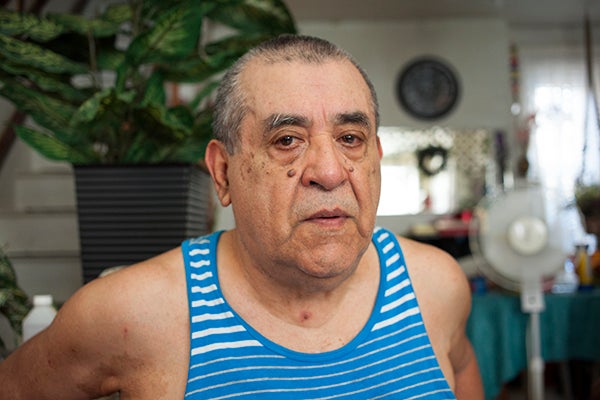
He said when it gets that hot, it feels like there’s no air inside. In the summers, he and his wife shower two to three times every day to deal with it.
He had on a tank top and sweat dripped down his face. A surgery scar peaked out of his shirt. He’s had heart surgery so the heat agitates him. He needs fresh air, he said.
I climbed a ladder to the top of Araujo’s house. Two roofers were finishing up the first layer of a cool roof coating. It’s a rubberized paint, but, importantly, it’s white, which means it reflects heat rather than absorbing it.
Rob Nolfi, a roofer who often works with ECA, used a roller to cover the black roof with the white coating. “The key is to be generous with it. You do not want to be cheap with it. Nice even coat, you just keep dipping,” he said.
Nolfi looked out over the neighborhood. Most of the roofs here are still black but around the city, the nonprofit, ECA, estimates about 40 percent of roofs are now reflective.
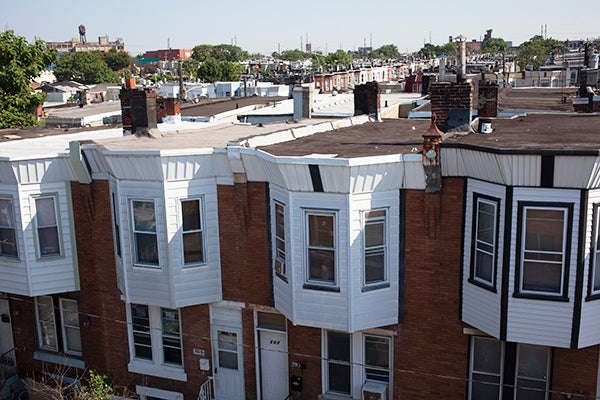
Nolfi said he just bought a new house and applied a cool roof. And his wife is happy with it. “She noticed that our bedroom was cooler,” he said.
The ECA estimates if the city can get to 60 or 70 percent reflective roofs, the cumulative effect will help cool the whole city and drive down health risks and costs for residents. “That will have an impact at the city scale, because it will be that much less building material absorbing the sun’s heat and re-emitting it into our space,” said Thomas Flaherty, with the ECA.
Back at my desk, I pull up a satellite image of Philadelphia. In some neighborhoods, black roofs still dominate. In others, white roofs spread across blocks with black just here and there. The aerial views make the streets look like piano keys.
Other cities are starting to think about ways to cool down and there are efforts to bring together scientists and policy makers to develop strategies for urban environments.
WHYY is your source for fact-based, in-depth journalism and information. As a nonprofit organization, we rely on financial support from readers like you. Please give today.




